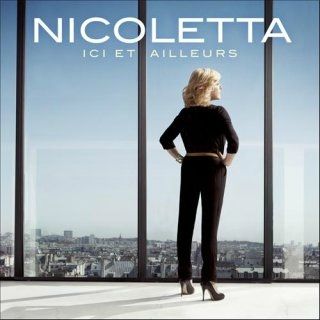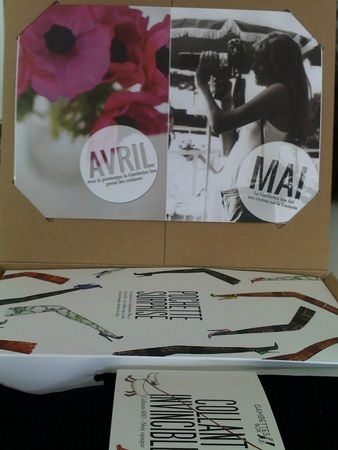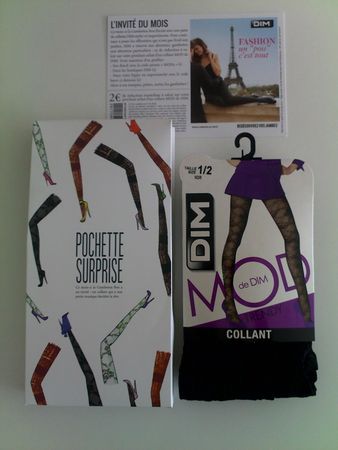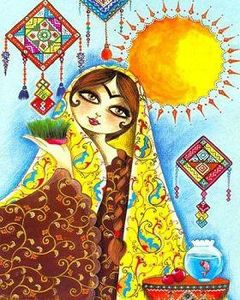Gambettes box (mars 2013) - Reçue !
Let's celebrate - Nowroz
Nowrūz (Persian: نوروز, IPA: [nouˈɾuːz], meaning "[The] New Day") is the name of the Iranian/Persian New Year in Iranian calendars and the corresponding traditional celebrations.Nowruz is also widely referred to as the "Persian New Year".
Nowruz is celebrated and observed by Iranian peoples and the related cultural continent and has spread in many other parts of the world, including parts of Central Asia, Caucasus, South Asia, Northwestern China, the Crimea and some groups in the Balkans.
Nowruz marks the first day of spring and the beginning of the year in the Iranian calendar. It is celebrated on the day of the astronomical Northward equinox, which usually occurs on March 21 or the previous/following day depending on where it is observed. As well as being a Zoroastrian holiday and having significance amongst the Zoroastrian ancestors of modern Iranians, it is also celebrated in parts of the South Asian sub-continent as the new year. The moment the Sun crosses the celestial equator and equalizes night and day is calculated exactly every year and Iranian families gather together to observe the rituals.
The term Nowruz is a Persian compound-word and consists of:
- now (Old Persian nava) means "new" and has the following cognates, in English new, in Latin novus, German neu, Sanskrit nava, etc. The Persian pronunciation differs in the many dialects of the language: while the eastern dialects have preserved the original diphthong (IPA: [næuˈɾoːz]), the western dialects usually pronounce it with a different diphthong (IPA: [nouˈɾuːz]), and some colloquial variants (such as the Tehrani accent) pronounce it with a monophtong (IPA: [noːˈɾuːz]).
- rōz (also with various pronuciations, such as rūz,rose.rooz rozh, or roj) means "day" in Middle- and Modern Persian. The original meaning of the word, however, was "light". The term is derived from Avestan *rowch-, itself derived from Proto-Indo-European *leuk- (l <-> r and k <-> ch sound changes are common in Indo-European languages), and is related to Sanskrit ruci, Latin lux, Armenian luys and, in fact, English light[citation needed].
Nowruz is celebrated in Greater Iran, Caucasus, Central Asia and by Iranians worldwide. It is a public holiday in Iran, Iraq, Afghanistan, Azerbaijan, Tajikistan,Turkmenistan, Uzbekistan, Kyrgyzstan and India. Also the Canadian parliament by unanimous consent, has passed a bill to add Nowruz to the national calendar of Canada, on March 30, 2009.
Nowruz in Afghanistan
Nowroz is celebrated widely in Afghanistan, particularly in the northern Afghan city of Mazar-e Sharif. Also known as Farmer's Day, the observances usually last two weeks, culminating on the first day of the Afghan New Year, March 21.During the Taliban rule (1996–2001), Nowruz was banned and considered an "ancient pagan holiday centered on fire worship". Preparations for Nowroz start several days beforehand, at least after Chaharshanbe Suri, the last Wednesday before the New Year. Among various traditions and customs, the most important ones are as following:
- Guli Surkh festival (Persian: ميلهى گل سرخ): The Guli Surkh festival which literally means Red Flower Festival (referring to the red Tulip flowers) is the principal festival for Nowroz. It is celebrated in Mazar-e Sharif during the first 40 days of the year when the Tulip flowers grow in the green plains and over the hills surrounding the city. Mazari Sharif is basically the center of Nawroz celebrations in Afghanistan. People from all over the country travel to Mazari Sharif to attend the Nawroz festivals. Various activities and customs are performed during the Guli Surkh festival, including the Jahenda Bala event and Buzkashi games.
- Jahenda Bālā (Persian: جهنده بالا; old persian zoroastrian term Zend or Zand Persian: ژند ): Jahenda Bala is celebrated on the first day of the New Year (i.e. Nawroz), and is attended by high-ranking government officials such as the Vice-President, Ministers, and Provincial Governors. It is a specific religious ceremony performed in the Blue Mosque of Mazar that is believed (mostly by Sunnite Afghans) to be the site of the tomb of Ali ibn Abi Talib, the fourth caliph of Islam. The ceremony is performed by raising a special banner whose color configuration resembles Derafsh Kaviani. This is the biggest recorded Nowroz gathering where up to 200,000 people from all over Afghanistan get together in Mazar central park around blue mosque to celebrate the banner raising (Jahenda Bālā ) ceremony.
- Buzkashi: Along with other customs and celebrations, normally a Buzkashi tournament is held during the Guli Surkh festival in Mazaris Sharif, Kabul and other northern cities of Afghanistan.
- Haft Mēwa (Persian: هفت میوه): In Afghanistan, people prepare Haft Mēwa (literally translates as Seven Fruits) instead of Haft Sin which is common in Iran. Haft Mewa is like a Fruit salad made from 7 different Dried fruits, served in their own syrup. The 7 dried fruits are: Raisin, Senjed (the dried fruit of the oleaster tree), Pistachio, Hazelnut, Prune (dry fruit of Apricot), Walnut and whether Almond or another species of Plum fruit.
- Samanak: It is a special type of sweet dish made from Wheat germ, and is normally cooked or prepared on the eve of Nawroz or a few days before the Nawroz. Women take a special party for it during the night, and cook it from late in the evening till the daylight, singing a special song: Samanak dar Josh o mā Kafcha zanem – Dochtaran* dar Khwāb o mā Dafcha zanem (* Dochter mains 1 daughter 2 young Lady or girl)
- Special cuisines: People cook special types of dishes for Nowroz, especially on the eve of Nowroz. Normally they cook Sabzi Chalaw, a dish made from rice and spinach, separately. Moreover, the bakeries prepare a special type of cookie, called Kulcha-e Nowrozī, which is only baked for Nowroz. Another dish which is prepared mostly for the Nowroz days is Māhī wa Jelabī (Fried Fish and Jelabi) and it is the most often meal in picnics. In Afghanistan, it is a common custom among the affianced families that the fiancé's family give presents to or prepare special dishes for the fiancée's family on special occasions such as in the two Eids (Eid ul-Fitr and Eid al-Adha), Barā'at and in Nowroz. Hence, the special dish for Nowroz is Māhī wa Jelabī.
- Sightseeing to Cercis fields: The citizens of Kabul go to Istalif, Charikar or other green places around where the Cercis flowers grow. They go for picnic with their families during the first 2 weeks of New Year.
- Jashn-e Dehqān: Jashn-e Dehqan means The Festival of Farmers. It is celebrated in the first day of year, in which the farmers walk in the cities as a sign of encouragement for the agricultural productions. In recent years, this activity is being performed only in Kabul and other major cities, in which the mayor and other high governmental personalities participate for watching and observing.
- Kampirak: Like "Haji Nowruz" in Iran, he is an old bearded man wearing colorful clothes with a long hat and rosary who symbolizes beneficence and the power of nature yielding the forces of winter. He and his retinue pass village by village distributing gathered charities among people and do his shows like reciting poems. The tradition is observed in central provinces specially Bamyan and Daykundi.
Source: http://en.wikipedia.org/wiki/Nowruz
Abonnement - Les essentiels de Glossybox
Bien que toujours dans l'attente de recevoir les boxes de My Little Paris et de Gambettes Box du mois de mars 2013, je me suis laissée tenter par un e-mail publicitaire concernant Les Essentiels de Glossybox. Il s'agit de la deuxième édition pour cette box qui est unique contrairement aux autres boîtes de Glossybox et autres ... Pour 11.00 euros je devrais bientôt recevoir 5 produits full-size 100% beauté plus un certain nombre de trouvaille pour le quotidien. La première édition n'était pas trop mal aussi j'ai hâte de recevoir celle-ci en espèrant que je serais safisfaite à 100%. Toujours d'après le e-mail publicitaire les boîtes sont programmées pour être envoyées à la fin du mois.
























/https%3A%2F%2Fprofilepics.canalblog.com%2Fprofilepics%2F5%2F9%2F592912.jpg)